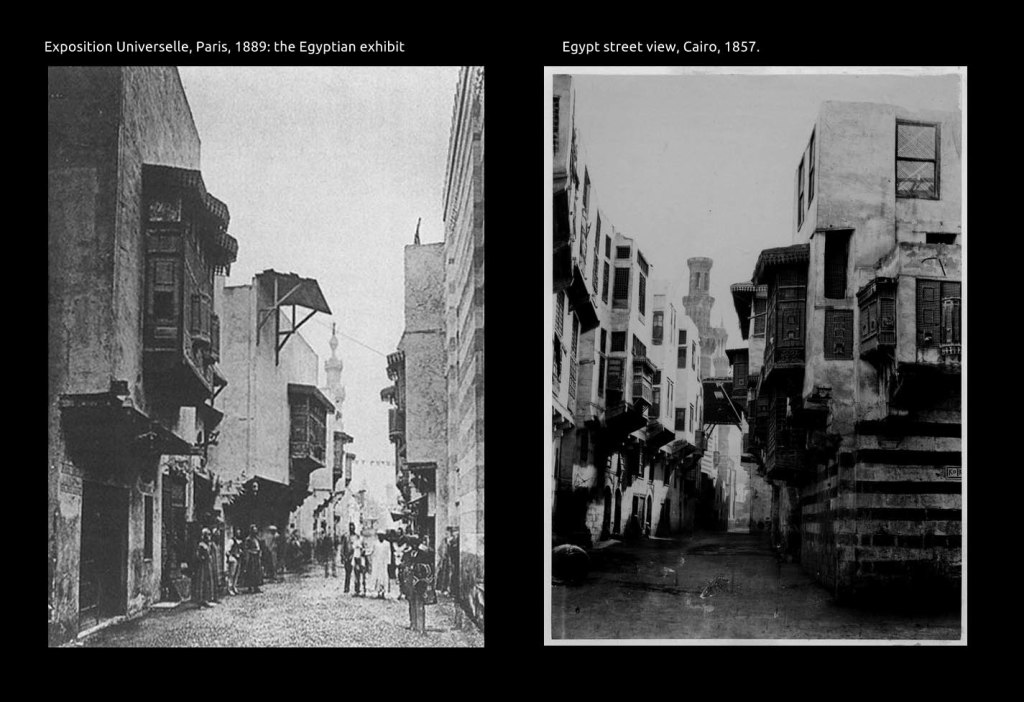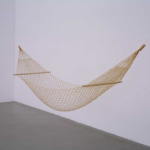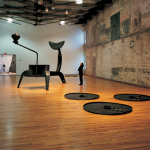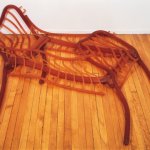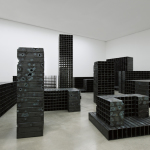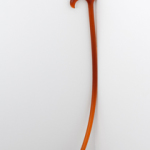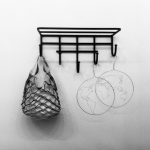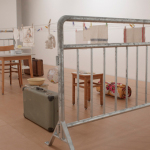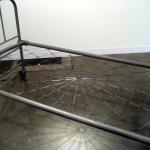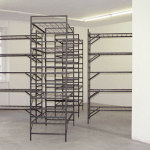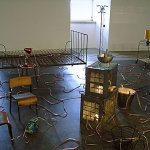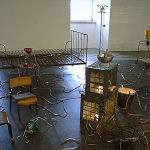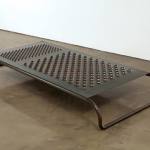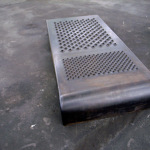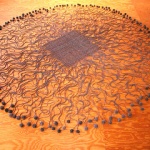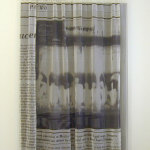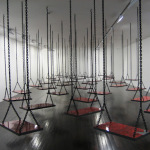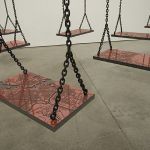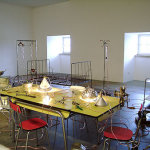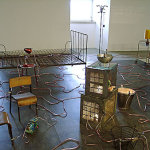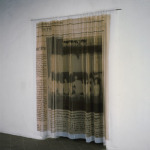Philosophies of the City | Week 12 Visibility/Enclosure: Can the Subaltern Speak?
The question isn’t “can the subaltern speak?” but “why can’t the subaltern speak?”
Presentation Outline
Can the subaltern speak?
Spivak’s blunt answer is no.
The question isn’t “can the subaltern speak?” but “why can’t the subaltern speak?”
- -it’s a problem of representation – the subaltern is formed out of its representation
- representation is framed and institutionalized
- language is discursive. the very rhetoric we use to describe and speak for the subaltern is discursive.
- if knowledge is presumed in discourse, then what is it that we don’t know out of discourse?
- so even if the subaltern spoke, we don’t have the capacity to hear – let alone understand.
- it’s not that they don’t have the capacity to speak. it’s that we don’t have the capacity to understand.
- because this, and we, exist through a western colonial apparatus of knowledge,
- If the subaltern woman spoke, what she says would still be misheard/misread and we would cast vices to her words through the same Euro-centric, orientalist lens that we have for centuries.
- political imperialism of europe as a colonial power in the east
- it has existed through a western colonial apparatus of knowledge
- when we learn about history we don’t learn that it is euro centric — we just learn
- even foucault and deleuze’s attempts to speak for the subaltern only reintroduce the euro-centric, male-dominant, orientalist framework that western historians have been trying to exist out of for decades.
- we must be critical of perspective. that we are within the apparatus to gain tools.
- darstellen and vertreten
- who are the subaltern?
- the othered subject is defined in exteriority, not as the self-determined “transparent I”
- this is all answered in section iv on 294
- unlearning female privilege
we are within the apparatus to gain tools. we are within the school of thought and we have to recognize that we are in it. by tethering the line — being inside that theoretical appartus — by step outside the line and critiqueing it becomes its own school of thought. tether the line as miopic when it comes to gender from a feminist post structuralist perspective. and we tether that line we reveal transnationalism and politics of self other in the third world . and when tether that line when we are confronted by the urban subproletariat in compardor countries. etc. etc. need to study legacies of discursive colonization. how our thinking is colonized. and that begins the process of unlearning.
….To the extent that Ranciere problematizes
- theatre and stage of something like the World Expo
- we present here two images where Spivak’s subaltern subject and Rancierre’s aesthetics of the sensible, particularly theatre and the stage as simultaneously a locus of public activity and the exhibition-space for ‘fantasies’ disturb the clear partition of identities, activities and space. coalesce to both question and establish key points in their texts.
This is from Timothy Mitchel’s Colonizing Egypt: the 1889 world expo in paris. to the left is the egyptian exhibit, complete with Frenchmen in egyptian costume and 50 egyptian donkeys they had imported. to the right is an image the street in egypt that was replicated.
He writes about these two Egyptian visitors who basically encounter a mirror at the egyptian exhibit, where they witness themselves displayed. and what happens and how they respond to this conflict of the return of the gaze.
Orientalism was in this context was like the master looking at the slave. and thus what happens when the slave looks back and acknowledges how he/she is perceived. but a “a speaking being is a political being. if a slave understands the language of its rulers however he does not possess it.” 13
The text describes the embarassment of the Egyptians, how they were disturbed… not even by how naturally bizarre it is to see somebody copy you but that it was so real. it was hauntingly authentic. as if they had no idea the french had beem studying them so closely. they are thrust into this orientalist world of staring. spectacle.
“There were two parallel pairs of distinctions, between the visitor and the exhibit, and between the exhibit and what it expressed. the representation was set apart from the real political reality it claimed to portray as the observing mind was set apart from what it observed.”
They could no longer exist outside world-as-exhibition.
This goes back to Spivak and the sort of normalization, the acceptance and normativity of the subaltern subject as subaltern essentialist identity. and that this ideology, representation enables a discourse to be constructed through authority. it becomes an academic construction, especially since the world expo operated as a didactic platform, right.. it becomes learned.
on the one hand the subaltern is made visible in this composed stage, on the other hand the stage becomes the very platform that excludes them and is an agent that disqualifies their capacity to speak.
one the one hand, it’s a didactic platform, on the other hand it clearly reveals who do the science and who are regarded as its objects.
To what extent does each image visibilize/invisibilize the subaltern?
“My problem has always been to escape the division between disciplines, because what interests me is the question of the distribution of territories, which is always a way of deciding who is qualified to speak about what. The apportionment of disciplines refers to the more fundamental apportionment that separates those regarded as qualified to think from those regarded as unqualified; those who do the science and those who are regarded as its objects.” 19
What is the distribution of the sensible?
The distribution of the sensible reveals who can have a share in what is common to the community based on what they do and on the time and space in which this activity is performed… it defines what is visible or not in a common space, endowed with a common language, etc
-in this context, ‘sensible’ refers to what is apprehended by the senses Thus the distribution of the sensible sets the divisions between what is visible and invisible, sayable and unsayable, audible and inaudible.
This distribution is composed of the a priori laws which condition what is possible to see and hear, to say and think, to do and make. It is important to stress this point: the distribution of the sensible is literally the conditions of possibility for perception, thought, and activity, what it is possible to apprehend by the senses. The sensible is partitioned into various regimes and therefore delimits forms of inclusion and exclusion in a community.
Mona Hatoum – Contemporary Subaltern Speech?
Through the works of Mona Hatoum, we can explore how domesticity, in relation to geographic space, is a revelation of colonial occupation. Of Palestinian descent, Hatoum was forced into exile from Lebanon when civil war broke out in 1975, which resulted in years of separation from her family. Her oppression through a transnational perspective resulted in numerous sculptures and video installations portraying identity as a stranger in a foreign land. Her work attempts to uncover the danger and reality of common things—when the familiar becomes grotesque, and grotesque becomes of something familiar. In her exhibit, “The Entire World as a Foreign Land,” we are thrust into a world where objects that are known to us become deformed, dislocated, dangerous and somewhat uninviting. These are domestic objects that are intended to have a purpose in the home but have instead, been rendered unhospitable, whose new unexplained purpose is waiting to be defined.
A door that would be an entrance to a room has been turned useless as the door handle is placed two feet above your head.
A kitchen is inadmissible as its entrance is banned by steel wires, and the kitchen’s utensils are strung together with electrical lines—their purpose left hazardous.
A seemingly common divan bed rests on the floor, only it is made of metal and decorated like a coffin.
A bed made limp, of rubbery wilt lies hobbled on the floor.
A wheelchair is parked with its push wheels non-existent, and its handles transformed into knives.
A series of kitchenware such as a meat grinder stands oversized, entailing its relation to the body as fatal.
A seemingly comfortable hammock hangs before a wall, rendered unusable because it is made of rubber bands.
A crib sits on a corner, made to look like an institutional metal bed suggestive of spaces of confinement such as asylums, penitentiaries.
She takes an ordinary curtain and inscribes it with a newspaper article describing an X-ray scan of illegal immigrants smuggled inside a truck, showing that we can’t, and shouldn’t, hide behind the covering comforts of home decor.
This collection of what seem to be ordinary objects constitute the feeling of being at home—a place to be at ease and at rest. On the contrary, they clearly instill the ironic elements of familiarity and strangeness—emanating polar sensations, designed to recall what we know, yet disturb this at the same time.
Is this the subaltern speaking?
- we bring mona hatoum because she’s a good example of the contemporary subaltern woman
- is her art and cultural production contemporary subaltern speech, spoken and heard?
we have to look at her work in the context of a transnational feminist post-structuralist perspective. and that she is the author and that she identifies as subaltern by virtue of her postcolonial struggle as a palestinian woman exiled. and we have to note rancierre’s text on art and work and the avant-garde, universality… does her work move beyond visibilizing the invisible… to the demo public that may see her work as simply ironic instead of being deeply rooted in her oppression as a subaltern woman? through art, does she turn the tables and render the subaltern avantgarde? narrative is it so good that it’s avantgarde and thus becomes exclusive.. does she transcend the subaltern question.. and does her fine art work, if deduced to assigning meaning to the ‘empirical’ world of lowly actions and commonplace objects, exist in a platform where we have the capacity to understand what is spoken?
– interjects in a mode of representation
– changing relation between surface and interior, sign and signified
– domestic objects rendered inhospitable

